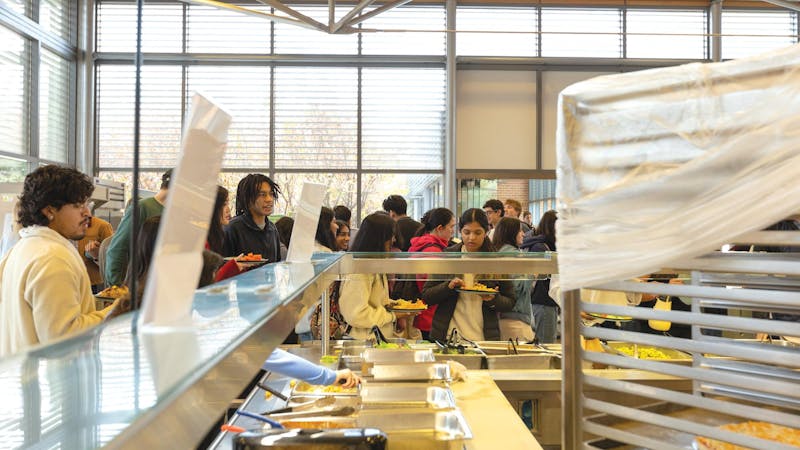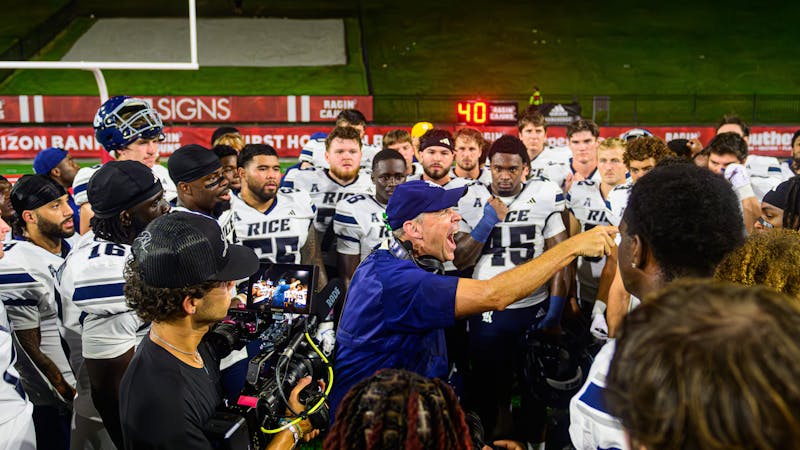Art around Willy's statue to honor donors
The statue of William Marsh Rice in the academic quadrangle may be getting a new neighbor. Construction has been planned in the academic quad to honor the members of the Rice University Legacy Society, a group of approximately 50 corporations, foundations and individuals who have contributed at least $4.6 million to the university, the amount Rice gifted in his will to establish Rice University. Construction may be completed in 2012, Rice President David Leebron said.
Martel College junior Ashley Hinton's design of concentric ellipses in the academic quadrangle won a competition that solicited all enrolled students for design proposals for the donor recognition.
The competition, which awarded a $5,000 prize, was President David Leebron's idea. Leebron said he was inspired both by the memory of seeing Rice architecture students' work in the past and the fact that Maya Lin, who designed the Vietnam War Memorial in Washington D.C., was also an undergraduate when she submitted her proposal.
The competition was announced in November 2008 by the judging committee, which featured Leebron, University Art Director Molly Hubbard, Vice President of Resource Development Darrow Zeidenstein, Professor of the School of Architecture Samuels David, Rice University Architect David Rodd, Rice Board of Trustees member Susie Glasscock (Jones '62), Chair of Building and Grounds Committee and Rice Board of Trustees member Ray Brochstein ('55), Professor Visual Arts Karin Broker, philanthropist Phoebe Tudor and Senior Philanthropic Advisor Sam Lasseter.
The committee received 21 designs by March 16 and narrowed the competition down to three finalist teams: Hinton, a team including Baker College junior Phoebe Kung and Brown College junior Diana Ang and a team consisting of Lovett College senior Sohael Chowfla and Hanszen College seniors Nicholas Elliott and Sanket Shah.
Each finalist team gave a 15-minute presentation to the judging panel on April 1. Shortly after her presentation, Hinton received a call informing her that her proposal was chosen.
Leebron said the panel was impressed with Hinton's sensitivity to the quad and her attention to the project's aspect of recognition.
"I think [the judges] liked the three 'S's' of Hinton's design: the symbolism, the subtlety and the simplicity," Leebron said. "What impressed me was that it's not easy to come up with a proposal that would be acceptable in the academic quadrangle. Also, given the definition of the Legacy Society, [the design] is symbolically almost perfect."
Hinton's tribute design consists of ellipses of Texas pink granite encircling the statue of William Marsh Rice and ascending in diameter toward the perimeter of the academic quad. The granite stones in the proposal are bronze-engraved with a Legacy Society member's name and inlaid in the ground to form solid rings.
Texas pink granite is the only granite domestically quarried and distributed in the United States, Hinton said, and is present in other buildings and art on campus such as Lovett Hall and 45, 90, 180 Degrees in the engineering quadrangle.
The granite rings are designed to be one foot wide, with each member's arced stone being two to three feet in length. The spacing and size of the ellipses is flexible enough to accommodate vents or any other obstructions in the central quad, Hinton said, adding that the rings came from her desire to pay tribute to the legacy members' relationship with Rice's founder without detracting attention from the statue of William Marsh Rice.
"[The rings] kind of function as tree rings, with William Marsh Rice at the center," Hinton said. "Essentially, as his legacy grows larger, there will be more rings."
Hinton said she heard of the competition through several Rice mailing lists and that the architecture school encouraged students to submit designs. She said she developed her design by visiting the basement of Fondren Library and studying aerial and topographic maps of Rice University.
Hinton said she also chose the academic quad as the location of her design because she knew no other buildings would be placed there and that the monument could be added to in perpetuity.
"When I decided I wanted to enter, I didn't want to create an object in space," she said. "I wanted to create something that would be part of the landscape, and in doing that, I wanted to put it in a place that wouldn't be touched, that would be more lasting."
Parameters for design submissions stated that the monument or tribute could be placed anywhere on campus but could not include a water feature and could not exceed $50,000 in construction costs. They required the capability to accommodate the approximately 50 Legacy Society members as well as any new members to be inducted in the future. Additionally, the committee will reserve the right to alter Hinton's design in any way before implementation.
Leebron said the selected design must attain approval from the Board of Trustees before construction can commence.
Runners-up Kung and Ang's proposal consisted of concrete structures covered in grass and Legacy Society member names in front of the Brochstein Pavilion, adding a utilitarian aspect because students would have been able to interact with the structures, Leebron said.
"Whether or not it was the legacy project, in some ways, I'd love to see it at Rice," he said. "It would create a playful area at Rice where students would be able to sit and lie. It created some challenges as far as the way the quadrangle would be used, but it was a brilliant proposal."
The third finalist proposal, designed by Chowfla, Elliott and Shah, was the most technologically-oriented and featured seven foot-long, lighted tubes coming out of the ground and lining the pathways adjacent to the Brochstein Pavilion. Leebron said the proposal was beautiful and reinforced one of the original goals of the Brochstein Pavilion, which was to cast more light on the campus in the evening.
Leebron said that while some of the proposals may not have been appropriate for the Legacy Society tribute, they would work to enrich and liven the campus.
"All of our students are amazing, but it was a real privilege to see these proposals and our students' ideas and dedication to Rice, to campus and to their fellow students," he said.
On April 21, all 21 design boards will be available for viewing in the Grand Hall of the Rice Memorial Center.
More from The Rice Thresher

Over 1,000 students petition against new meal plan
When Konstantin Savvon opened the Housing and Dining email announcing the new unlimited meal plan, he was instantly concerned about the impact on off-campus students like himself.

Rice football wins season opener under new coach
For the first time since 2018, Rice football opened its season with a victory. Scott Abell was soaked with yellow Powerade following a 14-12 win on the road Saturday against the University of Louisiana at Lafayette, which won 10 games and made it to the Sun Belt Conference championship last season.

Acting like an athlete: Rice basketball alum takes on Broadway
Underneath Chadd Alexander’s Broadway costume, there’s ankle tape and wrist braces — same protective gear he wore as a walk-on basketball player at Rice, though now he’s performing eight shows a week in the ensemble of “Harry Potter and the Cursed Child” instead of running conditioning drills in Tudor Fieldhouse.

Please note All comments are eligible for publication by The Rice Thresher.